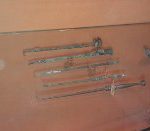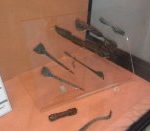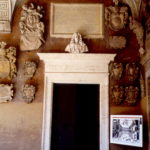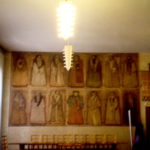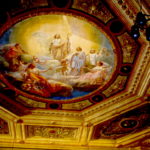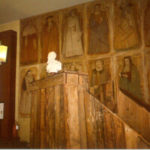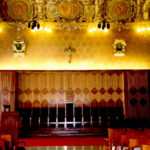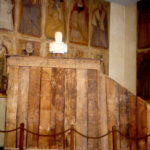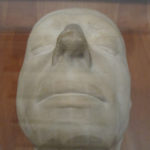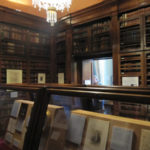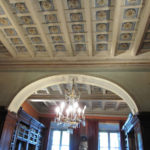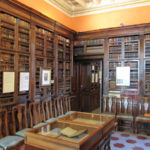Italy
ITALY
It was in Italy that the Renaissance, or the revival of learning, began and it was not long after this before some of their best thinkers turned their attention to natural phenomena. Great centers of scientific learning grew up, particularly in Florence, Bologna, Pisa, Venice, Padua, and later at Naples. By far the most famous and prominent Italian scientist has been Galileo Galilei (1564-1642). Although biology and medicine were not primarily his field of endeavor, his influence on all science was so great that we will have more to say about him. In the fields of biology and medicine, other Italians have played major roles. These include the Roman, Claudius Galen (130-200), Marcello Malpighi (1626-1694), Francesco Redi (1626-1697), Lazzaro Spallanzani (1729-1799) and others. Unfortunately nothing survives of their associations of which we are aware, and many of their important ideas have been superseded. Therefore we will devote this section of Italy to some of the traditionally great centers of scientific learning. It will also include an account of the anatomist, Andreas Versalius (1514-1564), who although not an Italian, taught and did his major work at Padua.
With Italy’s long and distinguished cultural history, going back to the Roman civilization and beyond, there is much more to see than just places of scientific interest, though often the latter are interwoven with the former. Italy has excellent roads in general, and their “autostrada” criss-cross the country making it easy to travel relatively long distances in a short period of time. There are also many rail and bus services as well. Rome, on the river Tiber, is the capital, and it will be convenient for us to take this as a central point of orientation, though there are also many convenient routes into northern Italy from France, Switzerland and Austria. We feel compelled to warn visitors to Italy that the opening hours of their institutions are very variable, and in addition there is no guarantee that they will be open even during the stated times!
FLORENCE
Location – 315 kilometers northwest of Rome.
Train – From Rome direct.
Road – Take the A1 Autostrada north from Rome, and then one of the many exits to Florence.
Florence, situated astride the Arno river, was an old Roman colony, and a military camp which Julius Caesar built in 59 B.C. It became of some importance under the Carolingian Emperors, but it was in the 15th and 16th centuries, when under the rule of the Medici family, that it rose to supreme cultural heights. In large measure this has been maintained ever since. During World War II, allied soldiers approaching the city were told that “The whole city must rank as a work of art of the first importance.” This accurately describes Florence, but it did not prevent terrible destruction. Some of Florence has gone forever, but today much restoration has taken place, and it is a very lovely place to visit. We cannot recommend too strongly a good historical guide book.
Before describing actual places of biological and medical interest in Florence, it will be well to give a short historical account of medicine in Italian universities, and Florence in particular. It is of great interest, and has something to teach us all.
During the Middle Ages, and starting about the 10th century, there was a school of medicine at Salerno, but no doctorate degree was given. Next in Italy came Bologna, first with law (1150) and then medicine. Art and music were also taught, but only law could receive a high degree. It was said that this was quite natural, because only law could be discussed, whereas medicine could not (i.e., the facts were known!). The man who eventually came to the defense of medicine was a Florentine, Taddeo Alderotti. He argued the case in Bologna, won the day, and about 1285 it became possible to aware a high degree in medicine. This in fact may be considered the origin of medical degrees as we know them today. Padua started as a university in 1222, with a faculty of medicine, but no high degree. This was followed 22 years later by the founding of the University of Naples by Frederick II.
The University of Florence was founded in 1321 and at its inception there was a medical school. Unfortunately neither the university nor the medical school functioned very well, mainly because it founders were merchants, who bargained for the professors and always thought they were paid too much – times have scarcely changed! Later the students ran the university, and in many cases hired the professors.
In the middle of the 16th century, Cosimo di Medici turned all the students out of Florence and sent them to Pisa. Florence was of course his capital, and like many a ruler, before and since, he viewed students as a threat. However, the Hospital of Santa Maria Nuova, founded at the end of the 13th century remained, including its school of surgery. The system evolved whereby the students took 4 years of theory at Pisa, and then went to the hospital in Florence for two years of clinical work, at the end of which they received a master’s degree in surgery.
In the 17th century some pupils of Galileo’s founded what was primarily a scientific academy at the Court of the Medici. It was called the Academia del Cimento, and they met occasionally in the Pitti Palace. Lorenza Bellini, Giovanni A. Borelli, Francesco Redi and Marcello Malpighi were all members of this academy, and exerted a major role in the advancement of science.
In the middle of the 18th century, the school of medicine at Florence was reformed by a professor of anatomy, Antonio Cocchi, and at the end of the century was again reorganized by the Grand Duke Pietro Leopoldo of Austria. The school was now “avant-garde”, for it had courses in pediatrics, dermatology, psychiatry and the history of medicine. There was also a pediatrics hospital, which dated from 1420 as a home for foundlings.
In 1840 disaster struck the still surviving school of surgery, in the form of another tyrannical ruler, Leopold II, who closed it and ordered the students to do everything at Pisa. It was not until 1859, after the war of independence, that a private school of medicine returned to Florence and was finally recognized by the state in 1923, and incorporated into the University of Florence.
Instituto e Museo Storia della Scienza
Piazza dei Giudici 1
Florence
Opening hours:
Daily, 10.00 – 13.00 and 14.00 – 16.00
Small charge for admission.
Besides Italian, some guides speak a little English and French.
This is an institute and museum of the history of Science, and is certainly one of the best in the world. It is situated near the Palazzo Castellani, on the banks of the Arno near the Ponte Vecchio, and adjoins the Uffizi Gallery. The displays in the museum are remarkably comprehensive and include biology and medicine, though they are heavily weighted in the history of physics and the work of Galileo (see under Pisa).
On the ground floor, where one enters, is an apothecary and chemistry (old chemistry) museum, also a collection of old clocks, including a pendulum clock attributed to Galileo. However, the main collections are on the first floor (second floor to us). These are displayed in 9 rooms as follows:
1. Mathematical instruments.
2. Mathematical and navigating instruments.
3. Geography and sundials.
4. Cosmography and geography.
5. The Galileo room, including lenses, telescopes and thermometers
associated with him, and some of his written works in original editions.
6. Telescopes of the 17th and 18th centuries, and microscopes of the
17th century.
7. Microscopes from the 18th century to the present.
8. Telescopes of the 18th and 19th centuries.
9. Various mechanical instruments.
Also in the hallways are portraits of many famous scientists.
On the second floor (third floor to us) there are 10 rooms with the following displays:
1, 2 and 3. These rooms are really a library of old and rare scientific
books, ranging back to the 14th century. One cannot help but
stand in awe as one looks at this superb and priceless
collection.
4. Mostly the history of cartography, but also displays where
instruments are matched to drawings in old books.
5. Lenses, including an incendiary lens of the 17th century, which
both Sir Humphrey Davey and Michael Faraday came to
Florence to see, in connection with their studies of the nature of fires.
6. Pneumatic instruments.
7. Electrostatic instruments.
8. Anatomy models.
9. Medical instruments and biological wax models.
10. Medical instruments.
This museum is under the direction of Professor Maria Luisa Righini Bonelli, and we cannot speak too highly of her expertise and achievements. We must note also that the museum carries on active research in the history of science, and tries constantly to expand its displays. Finally, we would warn the visitor to plan to spend some time here, as there is a great deal to see.
La Chiesa di Santa Croce
Piazza Santa Croce
Florence
Opening hours:
Variable, inquire locally.
This is an active church.
When Galileo died in 1642 he was buried in the churchyard of Santa Croce. However, 100 years later when the wrath of the church had somewhat died down, his body was transferred inside the church with a suitable monument, and this can be seen today.
Ospedale di Santa Maria Nuova
Piazza Santa Maria Nuova
Florence
Opening hours:
Normal business hours.
This is a working hospital.
This hospital was founded at the end of the 13th century, and interestingly enough the founder was Folco Portinari, the father of Beatrice, Dante’s inspiration. It is one of the oldest in the world, and played a major role in the development of early surgery.
Ospedale di Pediatria
Piazza S.S. Annunziata
Florence
Opening hours:
Normal business hours.
This is a working hospital.
This hospital was originally a home for foundlings, and dates from 1420. The architect was Filippo Brunelleschi (1379-1446). The building also has some magnificent sculpture by Luca della Robbia (1400-1482). At the side of the main entrance there is a bell placed low down, so that it could be rung by children seeking help. It is a very beautiful and interesting place, and one of the earliest pediatric hospitals in the world.
Biblioteca della Facoltà di Medicina
Policlinico di Careggi
Viale Morgagni
Florence
Opening hours:
Normal business hours.
No charge for admission.
This is a magnificent medical library, particularly rich in early medicine in Italy. It can only be used by special permission of the librarian, but visitors can ask to see it, and the librarians are very helpful.
Museo Zoologica La Specola
17 Via romana
Florence
Opening hours;
Variable, inquire locally.
Small charge for admission.
This museum has as its main display a very fine collection of biological wax models.
The visitor to Florence will of course want to see many more things than we have mentioned here, but in closing we would just like to suggest that you do not miss the Villa I Tatti, Via di Vincigliata. This contains the art collection and art history library of Bernard Berenson, left by him to Harvard University. It is a bit “out of the way,” but more than worth the effort to get there. It is open Monday – Friday only, 9.00 – 13.00 and 14.30 – 18.00. Closed for the month of August.
NAPLES
Location – 220 kilometers southeast of Rome.
Train – From Rome direct.
Road – Take the A2 Autostrada south from Rome and then one of the many exits to Naples.
The history of Naples goes back to at least 500 B.C. when it ws a Greek colony named Parthenope, and since then it has played an increasing part in Italian history. It is the third largest city in Italy with a popultion of over one million, a huge port, and set in beautiful surroundings with a sub-tropical climate.
Naples Archeological Museum
Stazione Zoologica di Napoli
Villa Comunale
Naples
Opening hours:
Normal business hours.
No charge for admission.
This is an active research institution. But by application to the main office, permission to see over it is usually granted.
The Villa Comunale is a park (in the center of which is the Stazione Zoologica) which borders the Via Caracciolol along the seafront. The Stazione Zoologica (Marine Biological Station) at Naples has played an enormous part in the development of all modern biology, and no one interested in the history of biology and medicine will want to miss it, not only for its historical significance, but also for its massive and imposing architecture all set in a beautiful park – regrettably often vandalized.
This marine biological station is by far the oldest in the world and set the pattern for the future. It was founded in 1872 by the young German doctor, Felix Anton Dohrn (1850-1909), who had studied both medicine and zoology at a variety of universities, but devoted his efforts to zoology. Anton Dohrn was “blessed” with a very rich father, Carl August Dohrn, who liked to support scientific research, and gave large sums of money to establish the station. There were also many other founding donors, including Charles Darwin. It was not exactly an accident that the foundation stone was laid in 1872, for that was the year that the famous Challenger Deep Sea Exploring Expedition set out, and a s a result of the Darwinian theory of evolution by natural selection (1859), many scientists were devoting their efforts to marine life in attempts to trace its evolutionary origins. At that time many were convinced that “ontogeny recaptiulates phylogeny”, i.e. that the embryological development of an individual animal recapitulates its evolutionary development. Thus it was thought that to explain evolutionary development, all that was necessary was to study embryological development. Unfortunately it did not prove that simple, but this was one of the main problems that early marine zoologists worked on at the station, and they soon found the many difficulties.
From the beginning the station’s main function was marine biological research, and still is. Anton Dohrn also insisted that it should be highly internationally oriented, and that scientists from all over the world should come there to work and exchange ideas. A truly far-sighted and very productive concept which has advanced biological knowledge enormously. To give an idea of the scientific importance of this first marine station, it is only necessary to note that over 20 Nobel Laureates have worked there at one time or another. We mention simply a few: Jacobus Van’t Hoff, Ilja Metschnikoff, Otto Warburg, Thomas Hunt Morgan, Otto Loewi, Albert von Szent-Gyorgyi, James Watson, Maurice Wilkins, George Wald and Karl von Frisch.
For most of its life (now well over 100 years) the station has been in private hands, but after World War II financial problems became so great that it was nearly forced to close. However, it is now under the direction of the Italian Ministry of Education, and it is hoped that better times are ahead.
Apart from the whole setting and structure of the station, there are two special things that the visitor should not miss. The first is the Marine Aquarium (one of the first in the world), which is currently (1984) undergoing extensive renovations. The second is the library, which apart from its up to date research holdings, is one of the best historical biological libraries in the world. The Archivist in Senora (Frau) Christiane Groeben, who is very knowledgeable and delighted to show visitors everything. In addition to her native German, she is fluent in Italian, French and English! She is also an excellent historian of biology.
The stazione Zoologica di Napoli has a distinguished place in the history of biology.
PADUA
Location – 525 Kilometers north and slightly west of Rome. 30 kilometers west of Venice.
Train – From Rome via Florence.
Road – Take the A1 Autostrada north from Rome, and follow this around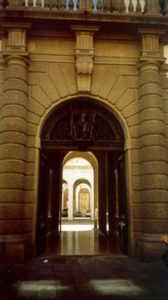
Florence to Bologna. At Bologna join the A13, which skirts Ferrara and
leads straight to Padua.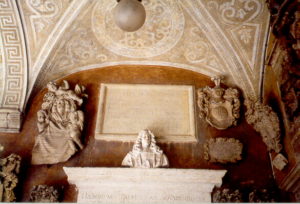
Padua is on the eastern side of the Valley of the Po in Northern Italy. It claims its origin from Troy, but in any case it was certainly an important town in Roman times. In 1337 it came under the rule of the Carrara family, and was subsequently taken by Venice in 1405. This had some influence on the cultural life of the city, because Venice was not dominated by the church in Rome, and Padua was able to establish centers of learning which were relatively free of religious dogma. Padua was taken by the French in 1797, and was ceded to Austira in 1814. It finally came under the rule of the modern Italian state in 1866. It has been sacked, destroyed and rebuilt many times over the centuries, but fortunately escaped major damage during World War II.
Università degli Studi di Padova
Via Roma e Via 8 Febbraio
Padua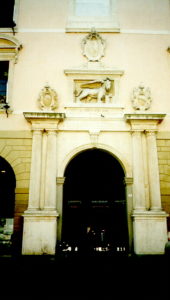
This is the central location of the University of Padua, and the main building here is universally called “Palazzo del Bo” (i.e., Ox Palace) or just plain “Bo”. The university is one of the oldest in the world, with origins going back to the 13th century. What is so important to us is that Galileo taught here, and during the 16th and 17th centuries it was the leading university of the world. This was particularly the case for its school of medicine. It is a truism that there can be no physiology without anatomy first, and it was during the 16th century in the medical school at Padua that human anatomy was put on a modern footing. In fact, the University of Padua can rightly claim to be the founding point of modern medicine. The person principally responsible for it was Andreas Vesalius (1514-1564).
Andreas Vesalius was of Flemish origin and born in Brussels in 1514. His family was poor, but he managed to enter the arts course at the University of Louvain, and in 1533 he went to the University of Paris to study medicine. At that time Paris was one of the leading medical schools, but like all medical schools of the day it was completely dominated by the “Galenic tradition,” and to understand the revolution in anatomy brought about by Vesalius, it is necessary to understand what was meant by this tradition.
Claudius Galen (130-200) was the foremost medical doctor of ancient Rome, and became the private physician to the Emperor Marcus Aurelius. For his day, he was skilled in all branches of medicine and wrote over 80 treatises on the subject. None of these survive in the original, but only as copies. Until about the beginning of the 16th century they comprised the standard and accepted views on medicine, particularly the works on anatomy. This was unfortunate, because in Galen’s day he was forbidden to dissect the human body and what his anatomical works consisted of was the anatomy of the barbary ape.
For about 1000 years the anatomy of the barbary ape and human anatomy were considered one and the same! As a student, Vesalius was taught Galenic anatomy. In 1536 he left Paris and returned to Louvain, where he was able to introduce human anatomical dissection into the medical curriculum. In 1537 he went to the University of Padua, still as a medical student, but so great was his knowledge that he was granted a doctor of medicine degree the same year, and the day after this was made an instructor in anatomy and surgery. He immediately introduced anatomical dissection into the curriculum. Even more importantly he did the dissection himself, rather than assign this important task to an assistant. Even though the number of human cadavers was very limited, he quickly learned that there were many differences between the anatomy of Galen and the realities of human anatomy, and he gave public lectures to demonstrate this. Very soon however, he was at work on what was to become a turning point in medical education, and by 1543 this manuscript was ready for publication.
Vesalius’ great work was entitled “De Humani Corporis Fabrica” (The Structure of the Human Body). It was printed and published in Basle, Switzerland in 1543. It is really a magnificent folio volume, and so accurate was it that it has often been said that medical students of today could learn their anatomy from this source without serious error. It is particularly notable for the standards of its illustrations. Traditionally these were said to have been done by the artist Jan Stephan van Calcar (c 1499-1550), who like Vesalius was Flemish, but this is not certain. However, there seems no doubt that they were done by students of the great Venetian artist Titian (1477-1576), and Calcar was one such student.
In retrospect it seems rather a pity that with the publication of “De Fabrica” Vesalius’ academic career was over. The same year it was published, he left the university and entered the service of the Emperor Charles V. Later still he became physician to Philip II of Spain, and spent the last years of his life in Spain. In 1564 he went on a trip to the Holy Land, and on the return journey his ship was forced ashore on a small island. Vesalius died there shortly afterwards. His grave is unknown. Nothing can erase his great achievement, and with the publication of “De Fabrica” the premier place of the University of Padua in medicine was even more firmly established than ever.
Students of medicine came from all over the world, one of those being William Harvey (see under Folkestone, Britain).
Palazoo Del Bo
Via Roma e Via 8 Febrraio
Padua
Opening hours:
Daily, 10.00 – 12.00 and 14.00 – 16.00
Small charge for admission.
This may be seen by guided tour only, and lasts about one hour. The tour is in Italian.
At street level the Palazzo del Bo consists of a modern courtyard, built in this century, and it has fascist motifs on the walls. There are also plaques in memory of the university’s war dead, all of whom “died for country and freetom” – it’s the same the world over! Within is an inner courtyard, dating from the 13th century, and there is an interesting tirual carried out here every time a professor dies. His coffin is placed in the center of the courtyard, and is then ceremoniously lifted three times by the students in tribute to the professor.
Upon entering the building the first anteroom is called the Hall of Rectors. The walls are covered with fescoes by famous artists, a beautiful bust of Galileo who was a professor here for 18 years, and one of Copernicus (1473-1543) who studied medicine here from 1501-1503. Next is the impressive Great Hall (Aula Magna). It has been rebuilt many times, and the present one dates from the 19th century. On the walls are the coats of arms of the families of Rectors before the 16th century. In that century the custom was abolished. On the wall behind the main podium is the university’s motto “Universa Universis Patavina Libertas” (Freedom to teach to everybody in Padua). The founders of the University of Padua were a group that broke away from the University of Bologna, where there was not freedom to teach. Despite this Padua, like so many other universities, has not always been able to live up to its motto.
After the Great Hall comes the Room of Forty. This is so called because on the walls are frescoes depicting 40 of Padua’s famous foreign students. They include Nicolaus Copernicus (1473-1543), William Harvey (1578-1657), Sir Frances Walsingham (1530-1590), Oliver Goldsmith (1728-1774), etc. Also in this room is the original lecture podium, from which Galileo taught between 1592-1610.
Next is the Room of Medicine, and it is the original room built by the architect Morone in the 13th century. This is the main meeting room of the faculty of medicine, and the place where the medical students receive their degrees. A very fascinating tradition is preserved here. During the inquisition in the 16th century, it was very difficult to obtain human bodies for dissection, but it was permitted to will one’s body for this purpose. In consequence of this it became the custom for the professors of anatomy to leave their own bodies to the medical school. In honor of those who did, their skulls were preserved and to this day occupy a prominent place in the Room of Medicine!
After the Room of Medicine comes the world famous Anatomy Theatre. It was built in 1594 by Fabrizio D’Acquapendente, and is by far the oldest in the world. It was also the first of its type, and proved to be the prototype of all later anatomy theatres. The great anatomist, Giovanni Battista Morgagni (1682-1771), taught here for over 50 years. To us this theatre is a true “gem” in the history of medicine. One cannot help being impressed by its small size, the lovely clear lines of its architecture and the beautiful wood carving. Despite its small size there are standing places for 300 students. The circumstances surrounding its origin are very interesting. As explained previously, cadavers were hard to come by in the 16th century because of the Inquisition, which forbade their dissection. Thus the Anatomy Theatre was deliberately built over a small canal. Dissections were always done at night, in order to be as inconspicuous as possible, and in addition the cadaver was floated on a barge down the canal under the theatre and simply lifted from the barge right onto the dissecting table. The opposite could and did take place, for when the professor got word that the papal police were on their way, the body was swiftly handed down onto the barge again and floated away. Such were the perils of anatomy in the 16th century! The visitor is allowed to walk in the theatre, and one can lie on the dissecting table to get a “cadaver eyed view” of the scene!
The theatre was used until 1772, but since then has essentially been a museum piece. During World War II, it was taken apart and stored in a safe place. When it was reassembled after the war it was placed on a site slightly removed from the original.
There are several other historical rooms in Bo, but it is not necessary to describe them further. Of great interest, however, is a café just across the street from the main entrance of Bo. This is the famous Caffè Pedrocchi, which dates from 1831. It is of striking architecture and has played a large part in the life of medical students at Bo, the latter always having been highly elite and male oriented. Since the inception of the Caffè, there has been an interesting custom carried out each year by the graduating class of medical students. Upon leaving the Room of Medicine, where their degrees are awarded, they ceremoniously march across the road to the Caffè Pedrocchi, where they proceed to drink heavily, and each student in turn has to stand up on his chair and boast about his sexual exploits during his years as a student. It is said that some fantastic stories have been told here! Before leaving Bo, the visitor should walk over the Piazza dei Signori and see the huge pre-Copemican Astronomical Clock, with the earth at its center, and the sun revolving around it.
Biblioteca Pinali
(Storia della Medicina)
Università Institute di Anatomica
Via Gabriele Falloppio 50
Padua
Opening hours:
By special arrangement (see below).
No charge for admission.
The Biblioteca Pinali is on the second floor of the Anatomical Institute
at Via Gabriele Falloppio 50. However, the numbering of the
street is confusing.
This is the old medical library of the university, with priceless collections of very ancient medical books – all beautifully maintained. Regrettably, the library is closed for lack of funds. However, by making special application of the Director of the Anatomical Institute, visitors are usually granted permission to see it. It is worth the effort.
Giardino Botanico
Via Orto Botanico 15
Padua
Opening hours:
April 1 – September 30, daily 9.00 – 13.00 and 15.00 – 18.00
October 1 – March 31, daily 9.00 – 12.00 and 14.00 – 16.00
On all Sundays and holidays, 9.00 – 13.00 only.
Small charge for admission.
These botanical gardens of the University of Padua are located near the Piazza del Santo, which is in the central part of the city. They were founded as part of the University of Padua in 1545 by an act of the Venetian Republic, and the original document still survives in the library. Their location, Renaissance layout and size are exactly the same as at the time of their foundation. At their inception the primary function was as a herb garden for the medical school, but even within the 16th century an Institute of Botany was founded with research as its main purpose, and this institute has played a major role in the development of scientific botany. It is interesting that Wolfgang von Goethe (1749-1832) visited these gardens in 1787 and this proved to be the inspiration for his work “The Metamorphosis of Plants”. In addition to the gardens there is a magnificent library, which while not open to the public can usually be seen upon request to the librarian. The library is divided into two parts, the new and the old. The new is a modern botanical research library, but the old is a historical botanic library and one of the best we have ever seen. Its works go back to the 15th century, and its Linnaean collection is especially good. This library is beautifully and lovingly kept by its staff, who are also very knowledgeable. Repairs to their books are still done by monks in the local monastery.
Before leaving Padua, we can only hope the visitor will also take the opportunity to see its wealth of art, architecture and sculpture.
PISA
Location – 300 kilometers northwest of Rome.
Train – From Rome direct.
Road – Take the A16 Autostrada to the noth and exit at Pisa. It may also
be reached from Florence via the A11 Autostrada.
Almost everyone knows that Pisa is the home of the “Leaning Tower,” but what is of far greater importance is that it was also the home of Galileo Galilei, one of the most influential scientists of all time.
Pisa on the Arno was originally a Greek colony, and is one of the many ancient towns in Italy, which through the centuries has suffered severely from the devastation of war (most recently World War II). At the same time, Pisa has managed to maintain a flourishing culture, and is a fascinating place to visit. It is regrettable that Galileo’s birth place in Pisa is unknown, or perhaps does not survive, but fortunately there are still some direct associations with him.
Università di Pisa
Via XXIX Maggia 15
Pisa
Opening hours:
Normal business hours.
No charge for admission.
This is Galileo’s university.
Galileo will forever be remembered as the person, who more than any other, challenged and eventually overthrew a way of thought based on speculation and dogma, which was the hallmark of the all-powerful ecclesiastical authorities. For this he substituted the experimental method, and deductions therefrom, which has become the major means of all scientific research. As a result he narrowly escaped with his life! But Galileo did much more than that.
He was born in 1564, the first child of a middle class family. Much of his early education was private, and at 14 he entered a monastery as a novice, intending to become a priest. However, 3 years later in 1581 he left the monastery and entered the University of Pisa as a medical student. It seems he was not very interested in medicine but studied a great deal of mathematics, and left in 1585 without a degree. Four years later he was offered the chair of mathematics at Pisa and in 1592 went to the University of Padua (see elsewhere) where he found a much freer atmosphere for his work, which prospered. His time in Padua lasted 18 years, but in 1610 he went to Florence as a private mathematician to the Grand Duke of Tuscany. Most historians of the period agree that this turned out to be a disastrous move for Galileo, as Florence at that time was a rigid society, dominated by the Church, and it is not surprising that in the end Galileo was one of its victims.
Over his relatively long life span, Galileo’s work and discoveries were vast, and we can only summarize them here. They included the discovery of the isochronism of pendulum oscillations, the equality of the velocities of falling bodies, the making of early thermometers and the refracting telescope, the latter making possible his astronomical observations and theories. He also very effectively applied mathematics to time and motion with undreamed of results. But, it was in 1632 that his greatest work was published. This was entitled “Dialogo sopra I Due massimi Sistemi del Mondo, Tolemaico e Copernicano” (Dialogue on the Two Chief Systems of the World, Ptolomaic and Copernican). Basically this book argued back and forth between the accepted Ptolomaic theory that the earth was the center of the universe and the heavenly bodies revolved around it, and the Copernican theory where the sun was central, and the earth was a plant revolving around the latter. Galileo’s telescopic observations and his calculations had of course convinced him that the Copernican theory was the reality. The year after “The Dialogue” was published he was brought before the Inquisition in Rome and forced to renounce his ideas. He also was to remain “under observation” for the rest of his life, which however was still spent under the patronage of the Grand Duke of Tuscany. He died in Florence in 1642.
The main building of the University of Pisa is located on Via XXIX Maggio between the Piazza Garibaldi and the Piazza Dante. The University of Pisa is one of the oldest in the world, with origins going back to the 12th century, but its chief claim to fame is that here towards the end of the 16th century, Galileo was successively both student and professor. The facade of the building is of recent construction, but the internal courtyard and balcony, which are of superb architecture, were built in the 15th century. It is really a thrilling experience to see this, and realize that Galileo himself walked this same courtyard. The library, located off the courtyard, is very rich in old scientific books, and contains some original documents of Galileo. The library is not open to the public, but visitors may make their requests known to the librarian, who in our experience was cooperative.
La Cattedrale
Piazza del Duomo
Pisa
Opening hours:
Variable, inquire locally.
This is an active church.
The Cathedral of Pisa is of 11th century origin, and contains many magnificent works of art. However, from our point of view it contains the so-called “Lamp of Galileo.” This is a great bronze chandelier strung from the ceiling of the cathedral. According to tradition it was while in church one day that Galileo observed the oscillation of the chandelier and subsequently established the isochronism of the oscillations of a pendulum. The tradition is quite possibly true, but in any case pleasant.
There are many other interesting things in the Piazza del Duomo, including the Leaning Tower.
ROME

The poet John Keats was born on October 31st, 1795 in a small village near London. His father was killed when he was eight years old and his mother married again for a short time. At fifteen, his mother died of consumption (TB) and he and his brothers were brought up by his grandmother and two guardians. Under the authority of his guardians, he became an apprentice to a London surgeon but because of a misunderstanding, left the surgeon and became a hospital student, receiving his apothecary license after four years of study. In 1814, at the age of nineteen, he became involved in the literary life. Two years later, he published his first poems. In 1818, after a coughing spell, he noticed blood in his phlegm and John recognized his own involvement with TB. In 1820, John was ordered by his physicians to avoid the English winter and emigrated to Italy. There he died on February 23, 1821 in Rome in an apartment adjacent to the Spanish Steps. His last words were, “Lift me up, I am dying. I shall be easy-don’t be frightened. Be firm and thank God it has come.” Three days later, he was buried by several of his friends in the Protestant cemetery.
Although his poems were not generally well received by critics during his life, together with Lord Byron and Percy Shelley he is one of the main figures of English Romantic poetry. His poems, especially his odes and letters, are some of the most popular in English literature.


